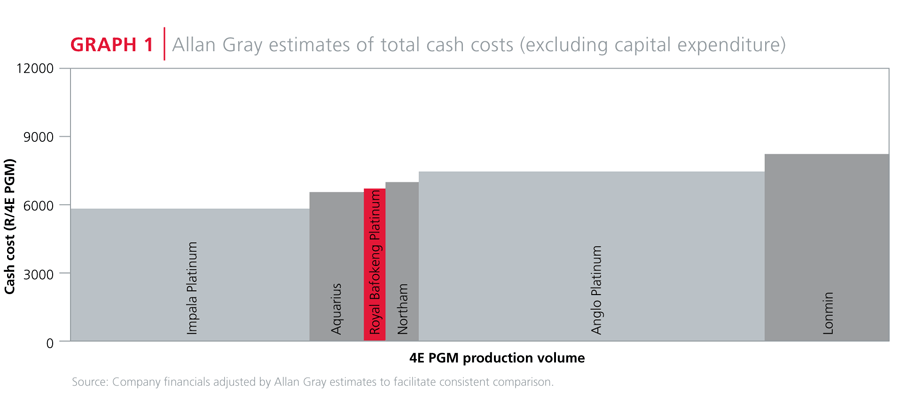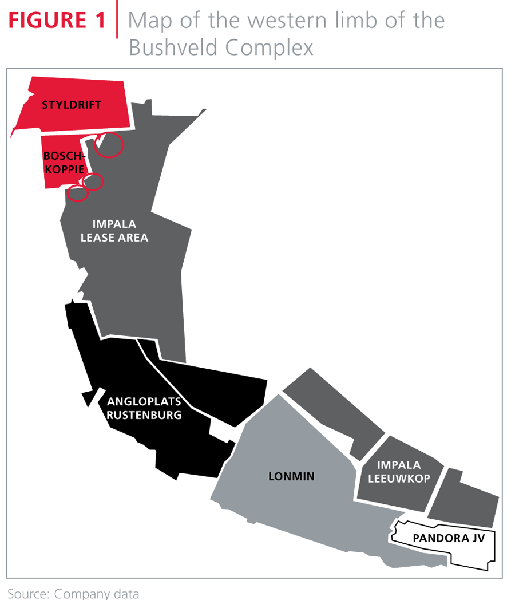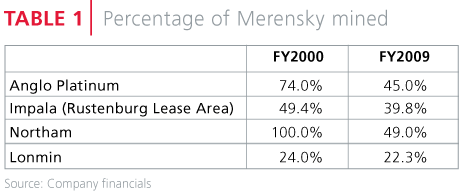On a relative basis, we believe Royal Bafokeng Platinum represents the most attractive value in the platinum sector. Upon listing, the Royal Bafokeng Nation (RBN) held 57% of the company. Rory Kutisker-Jacobson looks at the investment case for RB Plats and gives some insight into how the Bafokeng came to own such a sizeable stake in the business.
Royal Bafokeng Platinum (RB Plats) listed on 8 November 2010 at R60.50 per share, giving it a market value of just under R10 billion. At listing, the Royal Bafokeng Nation held 57% of RB Plats, Anglo Platinum held 12.7%, and the remaining 30.3% was made available to the public. Our client portfolios collectively own 5.1% of RB Plats.
For those interested in the fundamentals of the Platinum Group Metals (PGMs) Industry, I refer you to Quarterly Commentary 3, 2006. As our opinion has not changed materially, I do not repeat it here.
Given the current debate on nationalisation and questionable practices in awarding mining licences, one might ask how the Bafokeng came to own such a sizeable stake of the business. For centuries the Bafokeng people have occupied land between Rustenburg and Sun City, most of which lies above what is arguably the most valuable ore body in the world. A geological wonder, the ore body called the Bushveld Igneous Complex contains roughly 80% of the world's known platinum reserves. That below the Bafokeng land lies such a valuable ore body is fortuitous, but how they managed to retain their ownership and rights is not (see text box). The Royal Bafokeng Nation is a success all of its own making.
The argument for RB Plats
Situated north west of Rustenburg, RB Plats' sole asset is a 67% stake in the Bafokeng Rasimone Platinum Mine Joint Venture (BRPM). The remaining unlisted 33% is held by Anglo Platinum. BRPM in turn consists of two lease areas:
- Boschkoppie: An operational mine that currently produces approximately 180 000 ounces of platinum per year (approximately 4% of South African production); and
- Styldrift: A mine under development to add around 200 000 ounces of platinum per year by 2017, with potential for additional shafts in time.
Formulated in the late 1990s, BRPM came about when the RBN and Anglo Platinum pooled their respective mining rights over the Styldrift and Boschkoppie properties. The arrangement was recently restructured to allow RB Plats to have management control in anticipation of the listing.
On a relative basis, RB Plats represents, in our opinion, the most attractive value in the platinum sector
We find RB Plats attractive relative to its peers for several reasons:
1. Boschkoppie is a shallow mine with relatively low costs
Graph 1 depicts our estimate of the current cash costs for the major listed platinum companies per 4E PGM ounce (note these numbers include various adjustments we make and may not directly compare with those reported by the companies). Among others, the cash cost is a function of both the cost per ton mined, and the grade (mineral content) of the ore body. All else being equal, a higher grade results in a lower cost. Despite being in the bottom half of the industry cost curve, the cost per ton mined at Boschkoppie is relatively high for the depth of the mine, suggesting there is scope for further cost improvements.

2. Styldrift represents one of the best growth projects in the industry
Since 2006, despite cumulative capital expenditure in excess of R80 billion, the local platinum industry has been unable to grow production. From the peak in 2006 at approximately 5.3 million platinum ounces, production has actually declined to around 4.6 million ounces.
3. At present Boschkoppie mines (and Styldrift will mine) 100% Merensky reef
The Bushveld Complex consists of two platinum rich reefs, Merensky and UG2. In addition to having a lower platinum content, the UG2 reef has a high chrome content, which poses a challenge to the existing industry smelter capacity. High chrome content requires higher temperatures for melting and chrome can build up in the furnace hearth, both of which can lead to smelter blowouts and failures. Over time the amount of Merensky reef mined by the incumbents has declined, which has put pressure on them to find alternative sources of Merensky to feed into their smelters alongside the UG2 in order to keep the overall chrome content down (see Table 1). This makes BRPM of strategic importance and, at present, Anglo Platinum refines concentrate on its behalf on favourable terms.
4. BRPM is on the border of Impala Platinum's Lease Area, and significant synergies are possible
According to an agreement between the two parties, Impala will mine portions of the ore body below BRPM from existing Impala shaft infrastructure, in exchange for royalty payments to BRPM. This represents additional revenue for no additional costs or risks on the part of BRPM. Further royalty agreements are in the process of being concluded. The map in Figure 1 shows the location of BRPM relative to Impala and the other incumbents. Impala shafts under construction or in production bordering the BRPM assets are circled.

The strategic importance of BRPM from a growth, Merensky/ UG2 mix and location perspective was highlighted recently when Anglo Platinum blocked Impala's attempt to purchase the entire BRPM joint venture for just short of R20 billion. Impala's offer represented a premium in excess of 30% to the current implied market value of BRPM, which is R15 billion.

Risks associated with an investment in RB Plats
Problems at the existing mine, or in the development of Styldrift, could see operational performance fall short of expectations. Furthermore, the overall return of the company remains very dependent on the PGM basket price and rand/ dollar exchange rate, two factors outside management's control.
Although the current share price offers a thin margin of safety, this compares favourably with many shares on the JSE which we find expensive at current levels. On a relative basis, RB Plats represents, in our opinion, the most attractive value in the platinum sector, and the strategic importance of its assets somewhat mitigates the downside risk.
The listing of a platinum company of such magnitude is a rare event in South Africa, but what makes this particular listing unique is the history of the Bafokeng Nation.
In the 1860s, around the time diamond mining started in Kimberley, white farmers began to settle in the Rustenburg valley and register farms in their own names, ignoring the traditional rights of ownership enjoyed by the Bafokeng people for many centuries. Fearing the seizure of Bafokeng land, Kgosi August Mokgatle – then king of the Bafokeng – realised the Bafokeng would need to purchase farms to retain property to which they were, in essence, already entitled. Lacking funds, he ordered the young men of his tribe to make the trek to Kimberley to work in the diamond mines, bringing their savings home to be pooled in a community fund.
Legally prevented from acquiring property in their own name, the Bafokeng then sought the aid of Lutheran missionaries who would hold the title deeds on their behalf. In this manner, the Bafokeng nation began to acquire property as early as 1869, and over the next 30 to 40 years amassed some 900 hectares in the region. Over time the title deeds held by the missionaries were transferred to government to be held in trust for the Bafokeng nation as a collective.
Subsequently in the 1920s, geologist Hans Merensky discovered outcrops of the Bushveld Complex in the Rustenburg valley, and as luck would have it, a substantial portion of this ore body lay below land owned by the Bafokeng.
Over the next 70 years, there were several attempts to dispossess the Bafokeng of their land. Mines were constructed and the extraction of PGM and other minerals took place. Although the RBN contest that they were not paid sufficient royalties, they were able to retain their legal title and continued to acquire adjoining farms in the region. In the late 1990s, following the abolition of apartheid, the royalty structure was revised and the Bafokeng began to receive royalties of higher value.
Funds generated from the mines have been re-invested in the community and in their investment vehicle, Royal Bafokeng Holdings (RBH). The Bafokeng have used their income to build schools, roads, clinics and other infrastructure in the region, while RBH has grown to a company managing some R30 billion in assets.